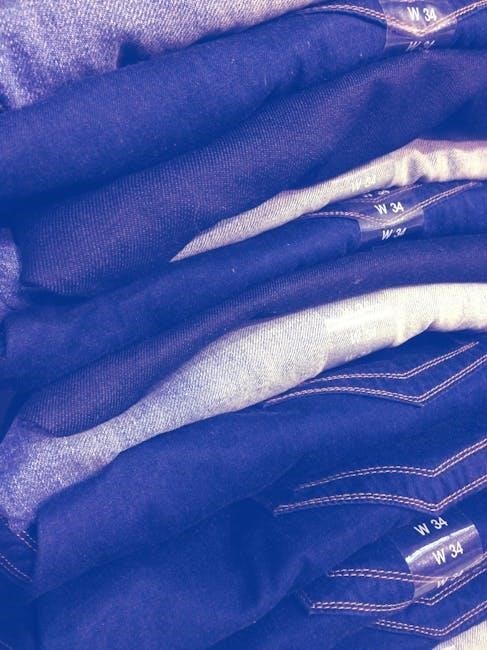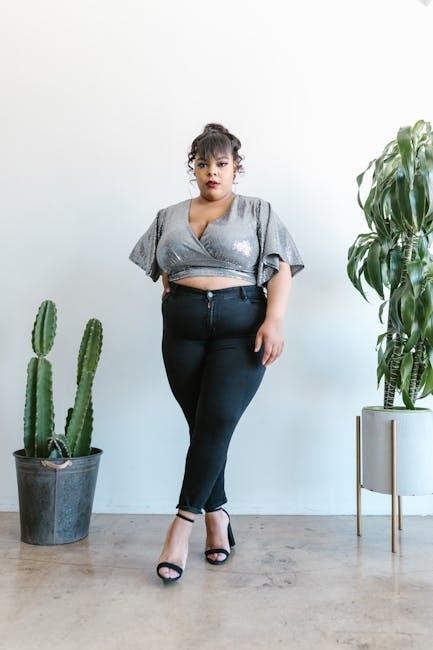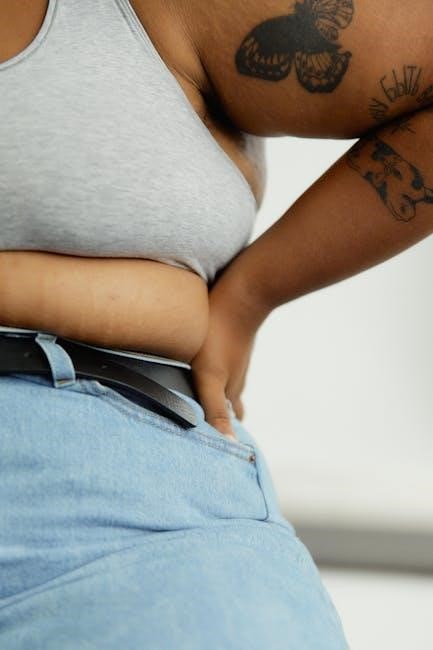Understanding Women’s Jeans Size Charts
Understanding women’s jeans size charts is crucial for a perfect fit. Sizes vary across brands, so standard measurements for waist, hips, and inseam are essential. Consider stretch ratios for comfort and accurate sizing.
1.1 How Jeans Sizing Differs Across Brands
Jeans sizing varies significantly across brands due to differences in target demographics, fabric types, and fit preferences. Some brands cater to specific body types or lifestyles, leading to diverse measurements. Vanity sizing and material stretch also play roles, affecting how sizes correspond to actual fit. Always consult a brand’s size chart for accuracy, as standards are not universal.
1.2 International Size Comparisons
Women’s jeans sizing varies significantly across international brands, with differences in measurements and labeling. US, UK, EU, and Australian sizes often differ, making conversions challenging. While some brands align closely, others may have unique sizing systems. Understanding these variations is key for accurate fits, especially when shopping globally or online. Always refer to the brand’s specific size chart for precise comparisons.

Measuring Yourself for the Perfect Fit
Accurate measurements are key to finding your ideal jeans size. Use a flexible tape measure to determine your waist, hips, and inseam for a precise fit.
2.1 How to Accurately Measure Waist and Hips
To measure your waist, wrap a flexible tape measure around your natural waistline, keeping it level and snug but not too tight. For hips, measure the widest point, usually 7-9 inches below your waist. Stand up straight and avoid slouching for accurate results. Ensure the tape is parallel to the floor for both measurements to get the best fit for your jeans.
2.2 The Importance of Inseam Measurements
Inseam measurements are crucial for determining the length of your jeans, ensuring they fit perfectly without dragging or being too short. Measure from the crotch seam to the bottom of the leg while the jeans are lying flat. Accurate inseam ensures comfort, proper styling, and prevents issues like tripping on excess fabric or uneven hems.

Jeans and Body Types
Jeans fit varies with body types, such as pear-shaped, hourglass, or rectangular. Understanding your shape helps choose flattering styles, ensuring comfort and confidence in your denim choice.
3.1 Jeans Styles for Different Body Shapes
Jeans styles cater to various body types, enhancing comfort and aesthetics. Pear-shaped bodies benefit from high-waisted or flared jeans, while hourglass figures shine in skinny or straight-leg styles. Rectangular body types can opt for boyfriend or relaxed fits to create curves. Understanding your shape helps in selecting the most flattering styles, ensuring both comfort and confidence in your denim choice.
3.2 How Body Type Influences Fit
Body type significantly impacts how jeans fit. Pear-shaped individuals often find high-waisted or flared styles flattering, while hourglass figures look great in skinny or straight-leg jeans. Rectangular body types benefit from boyfriend or relaxed fits, which add curve definition. Understanding your body’s proportions helps in selecting styles that create balance, ensuring a comfortable and flattering fit tailored to your unique shape.

Fabric and Stretch in Women’s Jeans
Fabric and stretch significantly impact comfort and fit. Denim blends with elastane offer flexibility, while 100% cotton provides durability. Choose fabrics that suit your lifestyle and preferences.
4.1 Different Denim Fabrics and Their Properties
Denim fabrics vary in composition and properties. 100% cotton denim is durable and breathable, ideal for classic styles. Stretch denim, blended with elastane, offers flexibility and comfort, perfect for skinny fits. Tencel denim combines softness and sustainability. Each fabric type balances durability, comfort, and style, catering to different preferences and lifestyles.
4.2 The Role of Stretch in Fit and Comfort
Stretch in jeans enhances fit and comfort by allowing flexibility. Elastane blends provide a snug fit and recovery, maintaining shape. Stretch fabrics reduce gapping at the waist and thighs, offering a tailored feel. They cater to active lifestyles, balancing style and ease without compromising durability, making them ideal for modern women seeking both fashion and functionality in their denim.

Popular Fit Styles in Women’s Jeans
Popular fits include skinny, slim, straight, boyfriend, and relaxed styles. Each offers unique comfort and aesthetics, catering to diverse body types and fashion preferences.
5.1 Skinny, Slim, and Straight Fits
Skinny jeans hug the legs tightly, offering a sleek look. Slim-fit jeans provide a tailored appearance without being too tight. Straight-leg jeans have a consistent width from thigh to ankle, suitable for most body types. These styles balance fashion and comfort, with stretch options available for enhanced flexibility and a flattering fit.
5.2 Boyfriend and Relaxed Fits
Boyfriend jeans offer a loose, casual fit with a masculine-inspired design, providing maximum comfort. Relaxed-fit jeans are slightly tapered but remain loose through the thigh and leg. Both styles are perfect for a laid-back look and often feature adjustable waistbands or rolled cuffs. They pair well with tucked-in tops or oversized sweaters, making them versatile for everyday wear.

Shopping for Jeans Online
Shopping for jeans online requires using size charts and customer reviews to ensure the best fit. Measure yourself and compare sizes across brands for accurate results.
6.1 Using Size Charts Effectively
Using size charts effectively involves measuring your waist, hips, and inseam accurately. Compare these measurements to the chart provided by the brand to find your best fit. Different brands may have varying sizing, so always refer to their specific guidelines. This ensures a more accurate fit and reduces the need for returns or exchanges.
6.2 Reading Customer Reviews for Fit Insights
Reading customer reviews provides valuable insights into how jeans fit and feel. Many reviewers share details about sizing accuracy, comfort, and stretch. Pay attention to comments about waist gaps, thigh tightness, or inseam length. Comparisons to other brands can also help validate your size choice. This feedback enhances your understanding of the fit beyond the size chart alone.

Common Fit Issues and Solutions
Addressing fit issues like waist gaps or tight thighs requires tailored solutions. Adjusting sizes, trying different styles, or alterations can resolve discomfort and ensure a flattering, comfortable fit.
7.1 Addressing Gaps at the Waist
Gaps at the waist in jeans often result from incorrect sizing or body type. To resolve this, ensure accurate waist measurements and consult size charts. Consider high-waisted styles or adjustable waistbands for a snug fit. If gaps persist, alterations or choosing a different rise can provide a more tailored solution for comfort and aesthetics.
7.2 Solving Tightness in the Thighs
Tightness in the thighs can be addressed by ensuring proper fit. Opt for jeans with a higher stretch percentage for comfort. Consider relaxed or boyfriend fits for more room. Accurate thigh measurements and trying different styles can also alleviate tightness. Fabric choice, like Tencel or cotton blends, may offer better flexibility and comfort, reducing discomfort in the thigh area.

Caring for Your Jeans
Proper care ensures longevity. Wash jeans inside out in cold water, avoid dryers, and store hung or folded to maintain shape and quality over time.
8.1 Washing Tips to Maintain Fit
To preserve the fit and quality of your jeans, wash them inside out in cold water to prevent shrinkage and fading. Use a mild detergent and avoid fabric softeners, as they can damage stretch fibers. Air-dry your jeans instead of using a dryer, as heat can alter their shape and size. Spot cleaning minor stains can also help maintain their original fit over time.
8.2 Proper Storage to Preserve Quality
Proper storage is key to maintaining the quality and fit of your jeans. Fold or hang them in a cool, dry place away from direct sunlight to prevent fading. Use breathable fabric bags or cotton covers to protect against dust and moisture. Avoid storing jeans in plastic bags, as this can cause mildew. Regularly cleaning and storing your jeans correctly ensures they retain their shape and size over time.

Future Trends in Jeans Sizing
Future trends include custom fits, sustainable materials, and advanced sizing technology. Brands are focusing on eco-friendly denim and personalized fits to meet diverse body types and preferences.
9.1 Custom and Bespoke Fits
Custom and bespoke fits are revolutionizing jeans sizing, offering tailored measurements for individual body types. Advanced technologies like AI and 3D scanning enable precise fits, while sustainable materials align with eco-conscious trends. This shift toward personalization ensures comfort, style, and reduced waste, catering to diverse preferences and body shapes for a perfect, unique fit every time.
9.2 Sustainable Sizing and Materials
Sustainable sizing emphasizes eco-friendly materials, like organic cotton and recycled fibers, to minimize environmental impact. Ethical practices reduce waste and ensure fair labor standards. By prioritizing sustainable fabrics and optimizing fit, brands decrease returns and alterations, fostering a greener fashion industry. Eco-conscious choices are essential for responsible denim production and a healthier planet.




Leave a Reply
You must be logged in to post a comment.